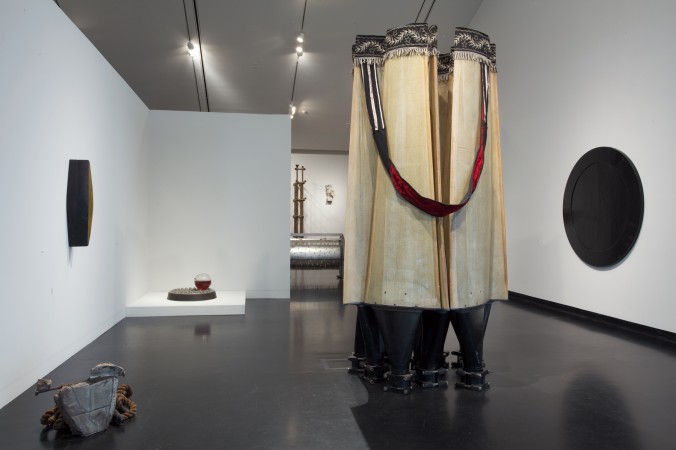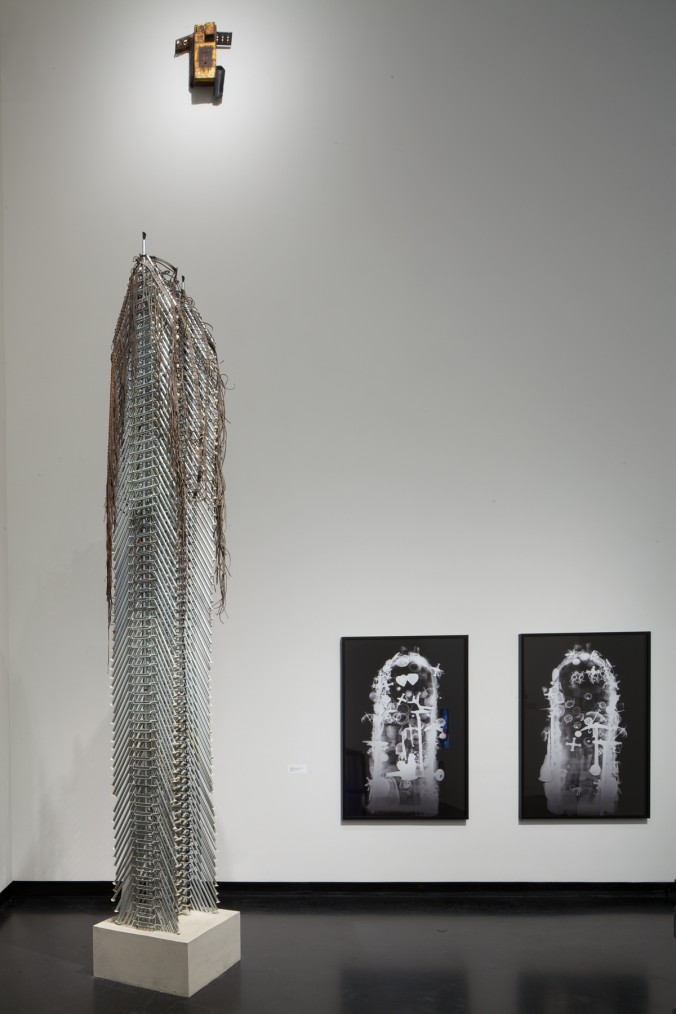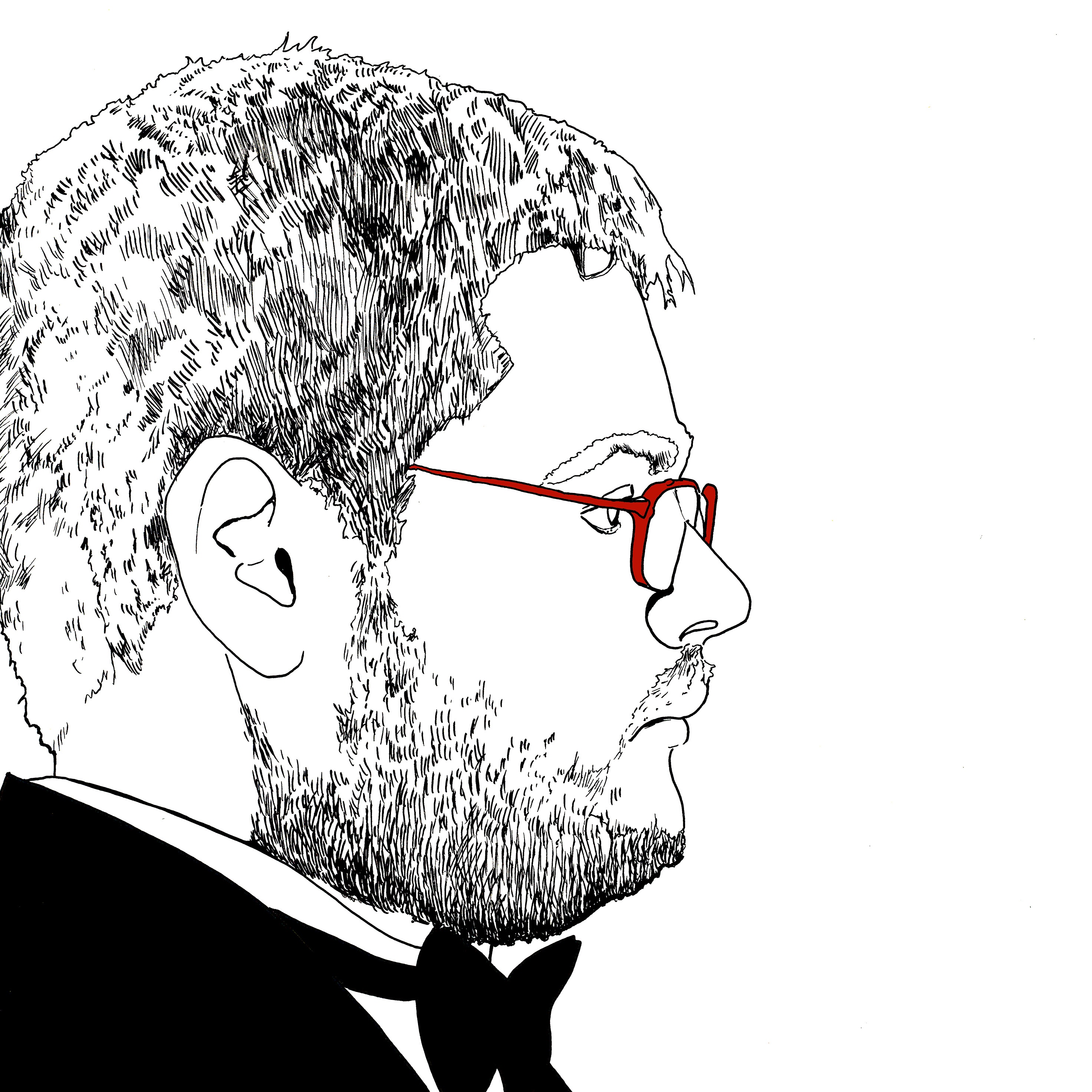
January 12, 2013: Terry Adkins, dressed in a priestly, black, dashiki-like garment, accented with a pink tapestry stole and an ornamented silver chain around his neck presided over the opening of his show of selected works at the Mary & Leigh Block Museum of Art. In this garb, Adkins gave off the air of an artist-priest, his manner calm and gracious. For Adkins, this is no costume. His sartorial presentation very much reflects the type of art he makes: art that strives to revive forgotten or under-represented aspects of cultural heroes’ lives — serious topics, approached with reverence. Focusing on figures such as blues icon Bessie Smith, rock-legend Jimi Hendrix, militant abolitionist John Brown, and sociologist / historian / philosopher W.E.B. Dubois, these cultural icons / warriors have significance to him personally, to African-American culture and American culture as a whole. Adkins aims for truth through the vocabularies of the assemblage and multimedia presentation. His work excels in the sculptural form where he transforms already beautiful industrial objects into sculptures imbued with his messages of historical recovery and what he would argue is the anagogic.
The panel discussion, held in conjunction with the opening of “Recital” is where Adkins presented the word anagogic to describe an aspect of his work, for which he always aims. As an important digression, the panel itself was remarkable owing to the impressive assembly of curators and artists on hand to celebrate and critique Adkins’s work: Naomi Beckwith of the Museum of Contemporary Art Chicago, Hamza Walker of the Renaissance Society, artists Dawoud Bey and Theaster Gates, Tang Museum director Ian Berry, and Northwestern art history professor Huey Copeland. The anagogic refers to a way of reading the spiritual or mystical in a work and requires one to look beyond the surface and materiality of objects.

One key to understanding the idea of the anagogic in Adkins’s work is that he tries not to materialize ideas, but to immaterialize the objects in the ideas. As an example, Adkins spoke about his musical practice. When playing, he said that his aim is to make the music real, to create a material presence with the sound. His performances can be ritual–like and the idea of conjuring presence through sound, if not explicit, can certainly be inferred in the performance context. And conversely, in his sculptural work he attempts to make the individual objects in his assemblages disappear and work together to form a new, powerful sign with anagogic potential addressing the subjects’ narratives on which he is focusing. A lofty aim to be sure, and many times Adkins hits his mark.
Sometimes, though, Adkins does not quite reach the anagogic as in one work from the “Black Beethoven” series. Skillfully executed, “Synapse” is a video work in which Adkins slowly transforms a portrait of Beethoven between a familiar, brooding, Euro-white representation to an Afro-black appearance of the same demeanor. Here, he is playing on the little known likelihood of Beethoven’s Moorish ancestry. However this seems trivial in the face of the larger cultural legacy: the insidious nature of the distribution of hegemonic cultural information (western classical music) over mediated networks (like through the media and education) forming complex power dynamics between those who hold power and those who do not. It is Adkins’s fascination with these small bits of information that sometimes can have too much influence on the outcome of a work. This is where I think a bit of critical confrontation is warranted, when he reaches a pedagogical moment and lets the work rest there.
Though, even when I find an Akdins piece leaving me wanting more (which is rare), for someone else who is not as familiar with the specific histories of the subjects he chooses, Adkins work is revelatory. One of the most successful pieces in this exhibit, “Darkwater Record,” consists of a stack of five vintage tape decks with a bust of Mao perched atop. The tape machines are all simultaneously playing excerpts of a W.E.B. Dubois speech titled, “Socialism and the American Negro.” There are no speakers attached — an interesting conceptual turn suggesting the silencing of this part of Dubois’s legacy. Also effective is the choice of tape machines with all-analog meters. Needles bouncing, the work reaches for the anagogic via the unheard traces of the voice on the tape.
Another piece I feel reaches the level of the anagogic is “Divine Mute.” The title seems to play with the trope of the seer who is blind, one who has vision, and in this case, perhaps one who hears divine commands but cannot speak. The work is a very large metal disk that protrudes out from the wall and is shaped somewhat like a mute for a brass instrument. Does this mute serve to silence the histories of the righteous? And who is the God who uses the mute or is being silenced? Adkins’s work is most successful when this kind of mystery is present.

________________________________________
“Recital”
Now thru 3/24/13
Mary & Leigh Block Museum of Art
@ Northwestern University, Evanston, IL
Performance at Block with Lone Wolf Recital Corps on March 1:







